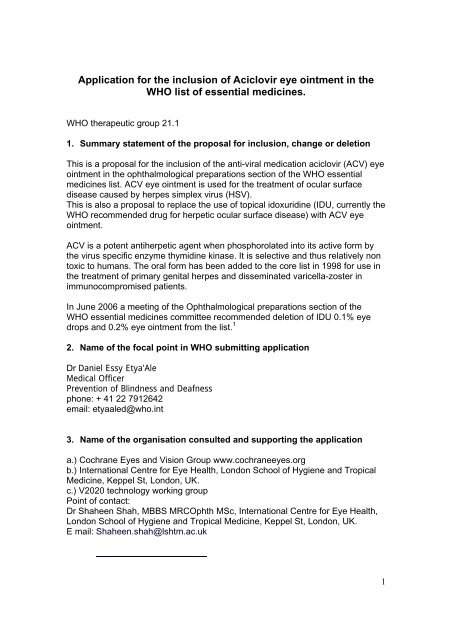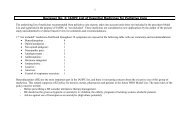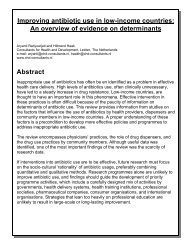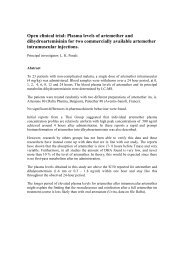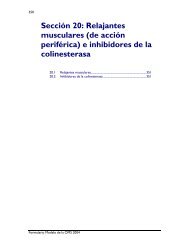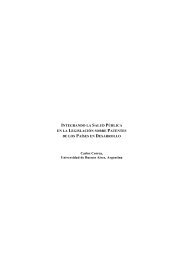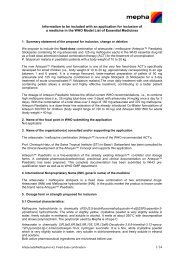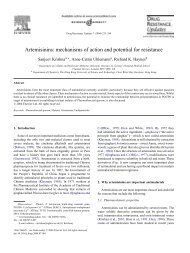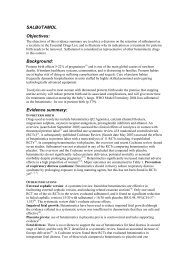Application for the inclusion of Aciclovir eye ointment in the WHO list ...
Application for the inclusion of Aciclovir eye ointment in the WHO list ...
Application for the inclusion of Aciclovir eye ointment in the WHO list ...
Create successful ePaper yourself
Turn your PDF publications into a flip-book with our unique Google optimized e-Paper software.
<strong>Application</strong> <strong>for</strong> <strong>the</strong> <strong><strong>in</strong>clusion</strong> <strong>of</strong> <strong>Aciclovir</strong> <strong>eye</strong> <strong>o<strong>in</strong>tment</strong> <strong>in</strong> <strong>the</strong><br />
<strong>WHO</strong> <strong>list</strong> <strong>of</strong> essential medic<strong>in</strong>es.<br />
<strong>WHO</strong> <strong>the</strong>rapeutic group 21.1<br />
1. Summary statement <strong>of</strong> <strong>the</strong> proposal <strong>for</strong> <strong><strong>in</strong>clusion</strong>, change or deletion<br />
This is a proposal <strong>for</strong> <strong>the</strong> <strong><strong>in</strong>clusion</strong> <strong>of</strong> <strong>the</strong> anti-viral medication aciclovir (ACV) <strong>eye</strong><br />
<strong>o<strong>in</strong>tment</strong> <strong>in</strong> <strong>the</strong> ophthalmological preparations section <strong>of</strong> <strong>the</strong> <strong>WHO</strong> essential<br />
medic<strong>in</strong>es <strong>list</strong>. ACV <strong>eye</strong> <strong>o<strong>in</strong>tment</strong> is used <strong>for</strong> <strong>the</strong> treatment <strong>of</strong> ocular surface<br />
disease caused by herpes simplex virus (HSV).<br />
This is also a proposal to replace <strong>the</strong> use <strong>of</strong> topical idoxurid<strong>in</strong>e (IDU, currently <strong>the</strong><br />
<strong>WHO</strong> recommended drug <strong>for</strong> herpetic ocular surface disease) with ACV <strong>eye</strong><br />
<strong>o<strong>in</strong>tment</strong>.<br />
ACV is a potent antiherpetic agent when phosphorolated <strong>in</strong>to its active <strong>for</strong>m by<br />
<strong>the</strong> virus specific enzyme thymid<strong>in</strong>e k<strong>in</strong>ase. It is selective and thus relatively non<br />
toxic to humans. The oral <strong>for</strong>m has been added to <strong>the</strong> core <strong>list</strong> <strong>in</strong> 1998 <strong>for</strong> use <strong>in</strong><br />
<strong>the</strong> treatment <strong>of</strong> primary genital herpes and dissem<strong>in</strong>ated varicella-zoster <strong>in</strong><br />
immunocompromised patients.<br />
In June 2006 a meet<strong>in</strong>g <strong>of</strong> <strong>the</strong> Ophthalmological preparations section <strong>of</strong> <strong>the</strong><br />
<strong>WHO</strong> essential medic<strong>in</strong>es committee recommended deletion <strong>of</strong> IDU 0.1% <strong>eye</strong><br />
drops and 0.2% <strong>eye</strong> <strong>o<strong>in</strong>tment</strong> from <strong>the</strong> <strong>list</strong>. 1<br />
2. Name <strong>of</strong> <strong>the</strong> focal po<strong>in</strong>t <strong>in</strong> <strong>WHO</strong> submitt<strong>in</strong>g application<br />
Dr Daniel Essy Etya'Ale<br />
Medical Officer<br />
Prevention <strong>of</strong> Bl<strong>in</strong>dness and Deafness<br />
phone: + 41 22 7912642<br />
email: etyaaled@who.<strong>in</strong>t<br />
3. Name <strong>of</strong> <strong>the</strong> organisation consulted and support<strong>in</strong>g <strong>the</strong> application<br />
a.) Cochrane Eyes and Vision Group www.cochrane<strong>eye</strong>s.org<br />
b.) International Centre <strong>for</strong> Eye Health, London School <strong>of</strong> Hygiene and Tropical<br />
Medic<strong>in</strong>e, Keppel St, London, UK.<br />
c.) V2020 technology work<strong>in</strong>g group<br />
Po<strong>in</strong>t <strong>of</strong> contact:<br />
Dr Shaheen Shah, MBBS MRCOphth MSc, International Centre <strong>for</strong> Eye Health,<br />
London School <strong>of</strong> Hygiene and Tropical Medic<strong>in</strong>e, Keppel St, London, UK.<br />
E mail: Shaheen.shah@lshtm.ac.uk<br />
1
4. International Nonproprietary Name (INN, generic name) <strong>of</strong> <strong>the</strong> medic<strong>in</strong>e<br />
<strong>Aciclovir</strong> <strong>o<strong>in</strong>tment</strong>, chemically denoted 9-(2-Hydroxyethoxymethyl) guan<strong>in</strong>e)) 2<br />
5. Formulation proposed <strong>for</strong> <strong><strong>in</strong>clusion</strong><br />
<strong>Aciclovir</strong> 3.0% W/W <strong>o<strong>in</strong>tment</strong><br />
FOR OPHTHALMIC USE ONLY<br />
6. International availability – sources, manufactures<br />
Zovirax ® <strong>eye</strong> <strong>o<strong>in</strong>tment</strong> is a registered trademark <strong>of</strong> <strong>the</strong> GlaxoSmithKl<strong>in</strong>e group<br />
<strong>of</strong> companies.<br />
O<strong>the</strong>r <strong>in</strong>ternational sources <strong>in</strong>clude:<br />
IDA Foundation<br />
Missionpharma<br />
Durb<strong>in</strong><br />
7. Whe<strong>the</strong>r <strong>list</strong><strong>in</strong>g is requested as an <strong>in</strong>dividual medic<strong>in</strong>e or as an example<br />
<strong>of</strong> a <strong>the</strong>rapeutic group<br />
Individual medic<strong>in</strong>e<br />
8. In<strong>for</strong>mation support<strong>in</strong>g <strong>the</strong> public health relevance (epidemiological<br />
<strong>in</strong><strong>for</strong>mation on disease burden, assessment <strong>of</strong> current use, target<br />
population)<br />
Herpes simplex is probably <strong>the</strong> most common virus acquired by humans. It is<br />
usually acquired <strong>in</strong> early life, one study f<strong>in</strong>d<strong>in</strong>g antibodies aga<strong>in</strong>st <strong>the</strong> virus <strong>in</strong><br />
50% <strong>of</strong> subjects with high socioeconomic status and <strong>in</strong> 80% <strong>of</strong> people with low<br />
socioeconomic status by <strong>the</strong> age <strong>of</strong> 30 years. 3 Humans are <strong>the</strong> only natural host<br />
and reservoir <strong>for</strong> <strong>the</strong> virus and antiviral drugs do not elim<strong>in</strong>ate latent virus. Thus<br />
bl<strong>in</strong>dness due to herpes virus rema<strong>in</strong>s a significant public health problem.<br />
The <strong>in</strong>cidence <strong>of</strong> ocular HSV is estimated at 21 to 31 per 100,000 people per<br />
year 4,5 and worldwide, up to 10 million people are thought to have a history <strong>of</strong><br />
ocular HSV. 6 Data from a long term study <strong>in</strong> Rochester, MN, USA, suggested<br />
that approximately 400,000 Americans have had ocular herpes and that<br />
approximately 50,000 episodes <strong>of</strong> new and recurrent ocular HSV <strong>in</strong> <strong>the</strong> USA<br />
occur annually. 5<br />
Ocular surface disease occurs predom<strong>in</strong>antly <strong>in</strong> two <strong>for</strong>ms. Dendritic epi<strong>the</strong>lial<br />
keratitis is virtually pathonemonic <strong>of</strong> HSV whereas geographic epi<strong>the</strong>lial keratitis,<br />
2
<strong>the</strong> macroulcerative <strong>for</strong>m, is less common. Comb<strong>in</strong>ed, Herpes Simplex Keratitis<br />
(HSK) accounts <strong>for</strong> approximately 70 to 80 per cent <strong>of</strong> all cases <strong>of</strong> ocular HSV.<br />
HSK is a result <strong>of</strong> <strong>in</strong>fection predom<strong>in</strong>antly with <strong>the</strong> HSV type 1 (HSV-1) virus. The<br />
7 8<br />
prevalence <strong>of</strong> HSK is estimated to be 149/100,000 <strong>in</strong> developed countries.<br />
Recurrent reactivation <strong>of</strong> latent virus is <strong>the</strong> pr<strong>in</strong>cipal cause <strong>of</strong> visual loss and <strong>the</strong><br />
reactivation pr<strong>in</strong>cipally takes <strong>the</strong> <strong>for</strong>m <strong>of</strong> dendritic <strong>in</strong>volvement. 8 The majority <strong>of</strong><br />
HSK cases occur <strong>in</strong> <strong>the</strong> work<strong>in</strong>g age group population, <strong>the</strong> mean age rang<strong>in</strong>g<br />
between 29 and 49 years. 4 Although predom<strong>in</strong>antly a unilateral disease, bilateral<br />
cases, occur<strong>in</strong>g <strong>in</strong> 1.2-12%, tend to be more severe and occur <strong>in</strong> younger ages.<br />
This may be particularly acute <strong>for</strong> low/middle <strong>in</strong>come countries where lack <strong>of</strong><br />
access to medical care is compounded by presence <strong>of</strong> malnutrition which lowers<br />
<strong>the</strong> resistance to HSV virus.<br />
The ma<strong>in</strong> impact on vision is through corneal scarr<strong>in</strong>g, th<strong>in</strong>n<strong>in</strong>g and<br />
neovascularization, particularly through recurrent attacks. 9 Although <strong>the</strong><br />
prognosis <strong>of</strong> visual loss subsequent to HSK has improved recently with <strong>the</strong><br />
<strong>in</strong>troduction <strong>of</strong> antiviral agents, it rema<strong>in</strong>s one <strong>of</strong> <strong>the</strong> lead<strong>in</strong>g causes <strong>of</strong> corneal<br />
opacities <strong>in</strong> high <strong>in</strong>come countries and is one <strong>of</strong> <strong>the</strong> most common causes <strong>of</strong><br />
corneal keratoplasty <strong>in</strong> <strong>the</strong>se countries. 4 In low and middle <strong>in</strong>come countries HSK<br />
is also a lead<strong>in</strong>g cause <strong>of</strong> corneal bl<strong>in</strong>dness and can account <strong>for</strong> up to 10% <strong>of</strong><br />
workload <strong>in</strong> corneal cl<strong>in</strong>ics. 10<br />
9. Treatment details (dosage regimen, duration; reference to exist<strong>in</strong>g <strong>WHO</strong><br />
and o<strong>the</strong>r cl<strong>in</strong>ical guidel<strong>in</strong>es; need <strong>for</strong> special diagnostic or treatment<br />
facilities and skills)<br />
Dosage regimen<br />
<strong>Application</strong> <strong>of</strong> 1cm (approximately ½ <strong>in</strong>ch) <strong>of</strong> <strong>o<strong>in</strong>tment</strong> to <strong>the</strong> <strong>in</strong>side <strong>of</strong> <strong>the</strong> lower<br />
lid on <strong>the</strong> affected side. The medic<strong>in</strong>e should be applied 5 times a day<br />
Duration<br />
Lesions typically heal after 5-9 days. 11 The <strong>o<strong>in</strong>tment</strong> is normally used <strong>for</strong> a<br />
m<strong>in</strong>imum <strong>of</strong> 3 days after <strong>the</strong> lesions have healed and <strong>the</strong> cornea has fully reepi<strong>the</strong>lialised.<br />
Storage<br />
This medication should be kept <strong>in</strong> a safe place below 25 0 C. The <strong>o<strong>in</strong>tment</strong> should<br />
not be used if more than one month has passed s<strong>in</strong>ce <strong>the</strong> tube was first used.<br />
Treatment Facilities<br />
No special facilities are required<br />
Diagnostic<br />
Approximately 90% <strong>of</strong> <strong>the</strong> studies detailed <strong>in</strong> this proposal utilized special corneal<br />
sta<strong>in</strong>s (ei<strong>the</strong>r fluoresce<strong>in</strong> or rose-Bengal) to detect corneal epi<strong>the</strong>lial status <strong>for</strong><br />
diagnosis <strong>of</strong> lesions and/or outcome assessment. Thus we recommend <strong>the</strong> use<br />
3
<strong>of</strong> corneal sta<strong>in</strong><strong>in</strong>g techniques <strong>for</strong> diagnosis and follow up <strong>of</strong> patients with<br />
herpetic ocular surface disease.<br />
Shelf Life<br />
5 years<br />
10. Summary <strong>of</strong> comparative effectiveness <strong>in</strong> a variety <strong>of</strong> cl<strong>in</strong>ical sett<strong>in</strong>gs<br />
• Identification <strong>of</strong> cl<strong>in</strong>ical evidence (search strategy, systematic reviews<br />
identified, reasons <strong>for</strong> selection/exclusion <strong>of</strong> particular data)<br />
As part <strong>of</strong> a comprehensive literature search, we identified a recent Cochrane<br />
systematic review entitled “Therapeutic Interventions <strong>for</strong> herpes simplex virus<br />
epi<strong>the</strong>lial keratitis”. This review <strong>in</strong>cluded controlled cl<strong>in</strong>ical trials that assessed<br />
<strong>the</strong> effects <strong>of</strong> one or more <strong>the</strong>rapeutic <strong>in</strong>terventions on <strong>the</strong> corneal epi<strong>the</strong>lial<br />
heal<strong>in</strong>g <strong>of</strong> participants with presumed herpes simplex virus epi<strong>the</strong>lial keratitis.<br />
The latest literature search (strategy outl<strong>in</strong>ed below) <strong>for</strong> this systematic review<br />
was conducted on 1 August 2006 and will be published <strong>in</strong> 2007 [Issue 5]. 6 The<br />
literature search date <strong>for</strong> <strong>the</strong> most recent published review <strong>of</strong> <strong>the</strong> work was 2003<br />
[Issue 4] 12 <strong>the</strong> results <strong>of</strong> which were neatly summarised by Barker. 13<br />
O<strong>the</strong>r sources <strong>of</strong> literature searched <strong>in</strong>cluded PubMed, Drugs and Therapeutic<br />
Bullet<strong>in</strong>, NICE, Scottish Intercollegiate Guidel<strong>in</strong>es Network and Prodigy.<br />
Literature reviewed<br />
The Cochrane review systematically searched <strong>for</strong> studies <strong>in</strong> CENTRAL (which<br />
conta<strong>in</strong>s <strong>the</strong> Cochrane Eyes and Vision Group Trials Register) on The Cochrane<br />
Library, MEDLINE and EMBASE. LILACS (Lat<strong>in</strong> American and Caribbean<br />
Literature on Health Sciences), BIOSIS, and JICT-EPlus were also searched up<br />
to 2005. To identify randomised controlled trials, this search was comb<strong>in</strong>ed with<br />
<strong>the</strong> Cochrane Highly Sensitive Search Strategy phases one, two and three as<br />
conta<strong>in</strong>ed <strong>in</strong> <strong>the</strong> Cochrane Handbook <strong>for</strong> Systematic Reviews <strong>of</strong> Interventions. 14<br />
Manual search<strong>in</strong>g <strong>in</strong>cluded Index Medicus from 1960 through 1965 and Excerpta<br />
Medica Ophthalmology from 1960 to 1973. Titles and abstracts <strong>of</strong> meet<strong>in</strong>gs held<br />
between 1980 and 2006 <strong>of</strong> <strong>the</strong> Association <strong>for</strong> Research <strong>in</strong> Vision and<br />
Ophthalmology (ARVO), <strong>the</strong> American Academy <strong>of</strong> Ophthalmology (AAO), <strong>the</strong><br />
Ocular Microbiology and Immunology Group, and <strong>the</strong> International Conference<br />
on Herpetic Eye Diseases were searched <strong>for</strong> cl<strong>in</strong>ical studies <strong>of</strong> herpetic keratitis.<br />
• Summary <strong>of</strong> available data (appraisal <strong>of</strong> quality, outcome measures,<br />
summary <strong>of</strong> results)<br />
Outcome Measures<br />
The primary outcome was <strong>the</strong> proportion <strong>of</strong> participants healed at seven days<br />
after study entry. To evaluate that <strong>the</strong> speed <strong>of</strong> heal<strong>in</strong>g correlated with overall<br />
treatment effectiveness, <strong>the</strong> secondary outcome was <strong>the</strong> proportion healed at 14<br />
days after study entry.<br />
4
Selection <strong>of</strong> Studies<br />
Studies were selected that had an unbiased allocation <strong>of</strong> two or more<br />
<strong>in</strong>terventions to participants with herpes simplex virus (HSV) epi<strong>the</strong>lial keratitis<br />
and that reported <strong>the</strong> status <strong>of</strong> participants by seven or 14 days after study entry.<br />
Assessment <strong>of</strong> methodological quality <strong>of</strong> <strong>in</strong>cluded studies<br />
Studies were assessed <strong>for</strong> <strong>in</strong>ternal validity, as noted <strong>in</strong> <strong>the</strong> Cochrane Handbook<br />
<strong>for</strong> Systematic Reviews <strong>of</strong> Interventions. 14 Each study was rated by <strong>the</strong> degree<br />
<strong>of</strong> plausible biases. The level <strong>of</strong> possible bias was based on three criteria: <strong>the</strong><br />
use <strong>of</strong> concealed randomised allocation <strong>of</strong> <strong>the</strong> <strong>in</strong>tervention, <strong>the</strong> use <strong>of</strong> mask<strong>in</strong>g <strong>of</strong><br />
participants and providers, and <strong>the</strong> use <strong>of</strong> slit-lamp biomicroscopy <strong>for</strong> determ<strong>in</strong><strong>in</strong>g<br />
eligibility and outcome.<br />
The searches identified 161 different cl<strong>in</strong>ical trials <strong>of</strong> herpes simplex virus (HSV)<br />
epi<strong>the</strong>lial keratitis. Sixty-three trials were excluded <strong>for</strong> methodological reasons or<br />
applicability. N<strong>in</strong>ety-eight trials, published between 1963 and 2006, were reta<strong>in</strong>ed<br />
<strong>for</strong> data analysis. Of <strong>the</strong> 98 <strong>in</strong>cluded trials 70% took place <strong>in</strong> Europe and only<br />
one took place <strong>in</strong> Africa. 78% <strong>of</strong> <strong>the</strong> trials were published <strong>in</strong> <strong>the</strong> English<br />
language. 6<br />
Nearly 70% <strong>of</strong> <strong>the</strong> <strong>in</strong>cluded studies specifically mentioned <strong>the</strong> use <strong>of</strong> a<br />
randomized allocation scheme. Attrition bias was uncommonly encountered as<br />
<strong>the</strong> primary endpo<strong>in</strong>t occurred with<strong>in</strong> two weeks <strong>of</strong> enrolment. A total <strong>of</strong> 5211<br />
participants were enrolled and analyzed <strong>in</strong> <strong>the</strong> 98 trials. 34 trials assess<strong>in</strong>g ACV<br />
<strong>eye</strong> <strong>o<strong>in</strong>tment</strong> were identified. 6 (Appendix Table 1)<br />
• Summary <strong>of</strong> available estimates <strong>of</strong> comparative effectiveness<br />
The results <strong>of</strong> <strong>the</strong> meta-analysis showed that all nucleoside antiviral medications<br />
were significantly better than placebo. ACV <strong>eye</strong> <strong>o<strong>in</strong>tment</strong> was significantly better<br />
than idoxurid<strong>in</strong>e at seven days (OR 4.69, 95% CI 3.13 to 7.02) and at 14 days<br />
(OR 4.18, 95% CI 2.48 to 7.03). 6 Results from <strong>the</strong> systematic review [Issue<br />
4,2006] compar<strong>in</strong>g ACV <strong>eye</strong> <strong>o<strong>in</strong>tment</strong> and Idoxurid<strong>in</strong>e are demonstrated <strong>in</strong><br />
Figure 1. 12 Triflurid<strong>in</strong>e and ACV <strong>eye</strong> <strong>o<strong>in</strong>tment</strong> appeared equivalent to one ano<strong>the</strong>r<br />
at seven days and 14 days. Vidarab<strong>in</strong>e was not shown to be better than ACV.<br />
O<strong>the</strong>r topical antiviral agents <strong>in</strong>clud<strong>in</strong>g bromov<strong>in</strong>yldeoxyurid<strong>in</strong>e,<br />
iododeoxycytid<strong>in</strong>e, ganciclovir, foscarnet and cid<strong>of</strong>ovir appeared equivalent <strong>in</strong><br />
cl<strong>in</strong>ical antiviral effectiveness to ACV, but few trials evaluated <strong>the</strong>se<br />
comparisons, and those that did were small.<br />
In summary, <strong>the</strong> meta-analysis found evidence to suggest that compared to<br />
idoxurid<strong>in</strong>e, <strong>the</strong> application <strong>of</strong> ACV <strong>eye</strong> <strong>o<strong>in</strong>tment</strong>, vidarab<strong>in</strong>e or triflurid<strong>in</strong>e<br />
generally resulted <strong>in</strong> a significantly greater proportion <strong>of</strong> participants heal<strong>in</strong>g<br />
with<strong>in</strong> one week <strong>of</strong> treatment. Among <strong>the</strong>se three antiviral agents, no treatment<br />
emerged as significantly better <strong>for</strong> <strong>the</strong> <strong>the</strong>rapy <strong>of</strong> dendritic epi<strong>the</strong>lial keratitis.<br />
5
Figure 1. Forest plot demonstrat<strong>in</strong>g comparison <strong>of</strong> <strong>Aciclovir</strong> and Idoxurid<strong>in</strong>e. Source: Cochrane review [Issue 4, 2006] 12<br />
6
In addition, unwanted side effects (follicular conjunctivitis, epi<strong>the</strong>lial keratopathy<br />
and st<strong>in</strong>g<strong>in</strong>g) were more common <strong>in</strong> patients us<strong>in</strong>g idoxurid<strong>in</strong>e compared to <strong>the</strong><br />
use <strong>of</strong> o<strong>the</strong>r topical nucleoside antiviral agents <strong>in</strong> a randomized double bl<strong>in</strong>d<br />
study. 15<br />
The question <strong>of</strong> prevention <strong>of</strong> ocular HSV disease was addressed by <strong>the</strong><br />
multicentre randomised controlled trial from <strong>the</strong> Herpetic Eye Disease Study<br />
group. 9 703 patients with a history <strong>of</strong> ocular HSV <strong>in</strong> <strong>the</strong> preced<strong>in</strong>g year were<br />
randomly assigned to receive oral ACV 400mg (n=357) or placebo (n=346) twice<br />
daily <strong>for</strong> one year. The cumulative probability <strong>of</strong> a recurrence was 19% <strong>in</strong> <strong>the</strong><br />
aciclovir treated group compared to 32% <strong>in</strong> <strong>the</strong> placebo group. The study<br />
concluded that long term oral prophylaxis is effective <strong>in</strong> reduc<strong>in</strong>g rate <strong>of</strong><br />
recurrence <strong>of</strong> ocular HSV. However <strong>the</strong> question raised that has not been<br />
answered to date regarded <strong>the</strong> duration <strong>of</strong> prophylaxis required to avert eventual<br />
progression <strong>of</strong> <strong>the</strong> disease.<br />
11. Summary <strong>of</strong> comparative evidence on safety<br />
• Estimate <strong>of</strong> total patient exposure to date<br />
The use <strong>of</strong> systemic ACV is generally well tolerated and has few side effects.<br />
ACV <strong>eye</strong> <strong>o<strong>in</strong>tment</strong> is <strong>list</strong>ed on <strong>the</strong> Medec<strong>in</strong>s sans Frontieres essential medic<strong>in</strong>es<br />
catalogue [ date accessed: 27 November 2006] and was added to <strong>the</strong> order <strong>list</strong> <strong>in</strong><br />
2002. 16<br />
One (4.5g) tube <strong>of</strong> ACV <strong>eye</strong> <strong>o<strong>in</strong>tment</strong> typically conta<strong>in</strong>s 135mg <strong>of</strong> ACV.<br />
• Description <strong>of</strong> adverse effects/reactions<br />
Contra<strong>in</strong>dications<br />
ACV <strong>eye</strong> <strong>o<strong>in</strong>tment</strong> is contra-<strong>in</strong>dicated <strong>in</strong> patients with a known hypersensitivity to<br />
aciclovir or valaciclovir. 17<br />
Special warn<strong>in</strong>gs and precautions <strong>for</strong> use<br />
Patients should avoid wear<strong>in</strong>g contact lenses when us<strong>in</strong>g ACV <strong>eye</strong> <strong>o<strong>in</strong>tment</strong>.<br />
Interaction with o<strong>the</strong>r medic<strong>in</strong>al products and o<strong>the</strong>r <strong>for</strong>ms <strong>of</strong> <strong>in</strong>teraction<br />
No cl<strong>in</strong>ically significant <strong>in</strong>teractions have been identified. ACV <strong>eye</strong> <strong>o<strong>in</strong>tment</strong> does<br />
not conta<strong>in</strong> sucrose, lactose, gluten or tartraz<strong>in</strong>e.<br />
Pregnancy and lactation<br />
Systemic adm<strong>in</strong>istration <strong>of</strong> ACV <strong>in</strong> <strong>in</strong>ternationally accepted standard tests did not<br />
produce embryotoxic or teratogenic effects <strong>in</strong> rats, rabbits or mice. 17 In a nonstandard<br />
test <strong>in</strong> rats, foetal abnormalities were observed, but only follow<strong>in</strong>g such<br />
7
high subcutaneous doses that maternal toxicity was produced. The cl<strong>in</strong>ical<br />
relevance <strong>of</strong> <strong>the</strong>se f<strong>in</strong>d<strong>in</strong>gs is uncerta<strong>in</strong>. A post-market<strong>in</strong>g ACV pregnancy<br />
registry has documented pregnancy outcomes <strong>in</strong> women exposed to any<br />
<strong>for</strong>mulation <strong>of</strong> ACV. The birth defects described amongst ACV exposed subjects<br />
have not shown any uniqueness or consistent pattern to suggest a common<br />
cause.<br />
The use <strong>of</strong> ACV <strong>eye</strong> <strong>o<strong>in</strong>tment</strong> should be considered only when <strong>the</strong> potential<br />
benefits outweigh <strong>the</strong> possibility <strong>of</strong> unknown risks.<br />
There is no <strong>in</strong><strong>for</strong>mation on <strong>the</strong> effect <strong>of</strong> ACV <strong>eye</strong> <strong>o<strong>in</strong>tment</strong> on human female<br />
fertility. Two-generation studies <strong>in</strong> mice did not reveal any effect <strong>of</strong> (orally<br />
adm<strong>in</strong>istered) ACV on fertility. Limited human data show that <strong>the</strong> drug does pass<br />
<strong>in</strong>to breast milk.<br />
Effects on ability to drive and use mach<strong>in</strong>es<br />
As this medic<strong>in</strong>e may cause vision to blur temporarily after application it is<br />
recommended not to drive or operate mach<strong>in</strong>ery until this effect has worn <strong>of</strong>f.<br />
Undesirable effects<br />
Transient mild st<strong>in</strong>g<strong>in</strong>g immediately follow<strong>in</strong>g application may occur <strong>in</strong> a small<br />
proportion <strong>of</strong> patients. 17 Superficial punctate keratopathy has been reported but<br />
has not resulted <strong>in</strong> patients be<strong>in</strong>g withdrawn from <strong>the</strong>rapy, and heal<strong>in</strong>g has<br />
occurred without apparent sequelae. Local irritation and <strong>in</strong>flammation such as<br />
blepharitis and conjunctivitis have also been reported.<br />
The results <strong>of</strong> a wide range <strong>of</strong> mutagenicity tests <strong>in</strong> vitro and <strong>in</strong> vivo <strong>in</strong>dicate that<br />
aciclovir does not pose a genetic risk to man. 17 ACV was not found to be<br />
carc<strong>in</strong>ogenic <strong>in</strong> long-term studies <strong>in</strong> <strong>the</strong> rat and <strong>the</strong> mouse. Largely reversible<br />
adverse effects on spermatogenesis <strong>in</strong> association with overall toxicity <strong>in</strong> rats and<br />
dogs have been reported only at doses <strong>of</strong> ACV greatly <strong>in</strong> excess <strong>of</strong> those<br />
employed <strong>the</strong>rapeutically. Oral ACV has been shown to have no def<strong>in</strong>ite effect<br />
upon sperm count, morphology or motility <strong>in</strong> man.<br />
There have been very rare reports <strong>of</strong> immediate hypersensitivity reactions<br />
<strong>in</strong>clud<strong>in</strong>g angioedema with ACV <strong>eye</strong> <strong>o<strong>in</strong>tment</strong>. 18<br />
Overdose<br />
No untoward effects would be expected if <strong>the</strong> entire contents <strong>of</strong> <strong>the</strong> tube<br />
conta<strong>in</strong><strong>in</strong>g 135 mg <strong>of</strong> ACV were <strong>in</strong>gested orally. 17 Oral doses <strong>of</strong> 800 mg five times<br />
daily (4 g per day) have been adm<strong>in</strong>istered <strong>for</strong> seven days without adverse<br />
effects.<br />
S<strong>in</strong>gle <strong>in</strong>travenous doses <strong>of</strong> up to 80 mg/kg have been <strong>in</strong>advertently<br />
adm<strong>in</strong>istered without adverse effects. ACV is dialysable by haemodialysis.<br />
8
12. Summary <strong>of</strong> available data on comparative cost and cost effectiveness<br />
with<strong>in</strong> <strong>the</strong> pharmacological class or <strong>the</strong>rapeutic group<br />
• Range <strong>of</strong> costs <strong>of</strong> <strong>the</strong> proposed medic<strong>in</strong>e (<strong>Aciclovir</strong> 3% ophthalmic<br />
<strong>o<strong>in</strong>tment</strong> ATC Code S01AD03)<br />
Date <strong>of</strong> access to International Drug Price <strong>in</strong>dicator: 28 November 2006<br />
Supplier<br />
Prices<br />
Prices are <strong>in</strong><br />
US$.<br />
Source Package Package Price Unit Price<br />
IDA 10 Tube (4.5 G) $ 4.00 0.0889/G<br />
MISSION 1 Tube (4.5 G) $ 0.61 0.1356/G<br />
DURBIN 1 Tube (4.5 G) $ 23.21 5.1570/G<br />
Buyers Price<br />
ETHIOPIA 1 Tube (4.5 G) $ 0.25 0.0556 /G<br />
CRSS 1 Tube (5 G) $ 1.70 0.3400 /G<br />
NAMIBIA 1 Tube (4.5 G) $ 5.49 1.2211 /G<br />
IDA Foundation is a not-<strong>for</strong>-pr<strong>of</strong>it organization support<strong>in</strong>g healthcare <strong>in</strong> low- and medium-<strong>in</strong>come<br />
countries by improv<strong>in</strong>g access to and deliver<strong>in</strong>g high-quality essential medic<strong>in</strong>es and medical<br />
supplies. IDA is an <strong>in</strong>dependent and self-support<strong>in</strong>g foundation, distribut<strong>in</strong>g more than 3,000<br />
products to over 100 countries worldwide. Orders under Euro 50,000 are charged a handl<strong>in</strong>g fee<br />
<strong>of</strong> 1.5%, with a m<strong>in</strong>imum fee <strong>of</strong> Euro 45. Prices are <strong>in</strong>dicative and may change.<br />
Missionpharma prices are given as an <strong>in</strong>dication only. There are no m<strong>in</strong>imum orders required or<br />
service charges.<br />
Durb<strong>in</strong> supplies pharmaceuticals and medical supplies to doctors, pharmacies, hospitals,<br />
pharmaceutical wholesalers and traders, military and government agencies, charities and o<strong>the</strong>r<br />
relief organizations worldwide.<br />
ETHIOPIA: The Pharmaceutical Adm<strong>in</strong>istration and Supply Service conducts an annual,<br />
<strong>in</strong>ternational, open tender.<br />
CRSS Costa Rica Social Security conducts an annual, <strong>in</strong>ternational, closed tender and negotiates<br />
contracts <strong>for</strong> drugs and medical supplies <strong>for</strong> its own facilities.<br />
NAMIBIA: The Namibia Central Medical Stores conducts an <strong>in</strong>ternational open tender every two<br />
years <strong>for</strong> pharmaceuticals and medical supplies.<br />
• Comparative cost effectiveness presented as range <strong>of</strong> cost per rout<strong>in</strong>e<br />
outcome (e.g. cost per case)<br />
ACV belongs to <strong>the</strong> nucleoside antiviral group <strong>of</strong> medic<strong>in</strong>es. The alternatives to<br />
ACV <strong>eye</strong> <strong>o<strong>in</strong>tment</strong> <strong>in</strong>clude; topical vidarab<strong>in</strong>e, topical triflurid<strong>in</strong>e and topical<br />
bromov<strong>in</strong>yldeoxyurid<strong>in</strong>e (BVDU).<br />
Topical triflurid<strong>in</strong>e is manufactured under <strong>the</strong> brand name Viroptic® 1%. Limited<br />
<strong>in</strong><strong>for</strong>mation is available on drug pric<strong>in</strong>g. (see Appendix)<br />
Idoxurid<strong>in</strong>e was removed from market <strong>in</strong> 1990s due to low demand. 6<br />
9
13. Summary <strong>of</strong> regulatory status <strong>of</strong> <strong>the</strong> medic<strong>in</strong>e (<strong>in</strong> country <strong>of</strong> orig<strong>in</strong>, and<br />
preferably o<strong>the</strong>r countries as well)<br />
N/A<br />
14. Availability <strong>of</strong> pharmacopoeial standards (British Pharmacopoeia)<br />
Yes <strong>list</strong>ed <strong>in</strong> major pharmacopoeias <strong>in</strong>clud<strong>in</strong>g British National Formulary.<br />
15. Proposed (new/adapted) text <strong>for</strong> <strong>the</strong> <strong>WHO</strong> Model <strong>for</strong>mulary<br />
<strong>Aciclovir</strong> <strong>eye</strong> <strong>o<strong>in</strong>tment</strong> 3% W/W ophthalmic preparation<br />
Uses:<br />
FOR OPHTHALMIC USE ONLY<br />
Adults: Herpetic ocular surface disease (dendritic or geographic herpetic<br />
epi<strong>the</strong>lial keratitis)<br />
Children: As <strong>for</strong> adults<br />
Elderly: As <strong>for</strong> adults.<br />
Interactions:<br />
No cl<strong>in</strong>ically significant <strong>in</strong>teractions have been identified.<br />
Contra<strong>in</strong>dications:<br />
<strong>Aciclovir</strong> is contra-<strong>in</strong>dicated <strong>in</strong> patients with a known hypersensitivity to aciclovir<br />
or valaciclovir. Patients should avoid wear<strong>in</strong>g contact lenses when us<strong>in</strong>g <strong>the</strong> <strong>eye</strong><br />
<strong>o<strong>in</strong>tment</strong>.<br />
Precautions:<br />
Systemic adm<strong>in</strong>istration <strong>of</strong> aciclovir is <strong>in</strong>ternationally accepted; standard tests did<br />
not produce embryotoxic or teratogenic effects <strong>in</strong> rats, rabbits or mice. However,<br />
it is suggested that <strong>the</strong> use <strong>of</strong> aciclovir <strong>eye</strong> <strong>o<strong>in</strong>tment</strong> <strong>in</strong> pregnancy should be<br />
considered only when <strong>the</strong> potential benefits outweigh <strong>the</strong> possibility <strong>of</strong> unknown<br />
risks. Limited human data show that <strong>the</strong> drug does pass <strong>in</strong>to breast milk.<br />
Overdose:<br />
No untoward effects would be expected if <strong>the</strong> entire contents <strong>of</strong> <strong>the</strong> tube<br />
conta<strong>in</strong><strong>in</strong>g approximately 135 mg <strong>of</strong> aciclovir were <strong>in</strong>gested orally.<br />
10
References<br />
1. <strong>WHO</strong> Essential Medic<strong>in</strong>es List- Ophthalmological Preparations 15th Expert<br />
Committee on <strong>the</strong> Selection and Use <strong>of</strong> Essential Medic<strong>in</strong>es<br />
<strong>WHO</strong>, 2006.<br />
http://mednet3.who.<strong>in</strong>t/EML/expcom/expcom15/applications.htm#M<br />
2. Elion GB, Furman PA, Fyfe JA, de Miranda P, Beauchamp L, Schaeffer HJ. The<br />
selectivity <strong>of</strong> action <strong>of</strong> an antiherpetic agent, 9-(2-hydroxyethoxymethyl) guan<strong>in</strong>e.<br />
Reproduced from Proc. Natl. Acad. Sci. USA 74, 5716-5720 (1977). Rev Med<br />
Virol 1999;9(3):147-52; discussion 152-3.<br />
3. Nahmias AJ, Lee FK, Beckman-Nahmias S. Sero-epidemiological and -sociological<br />
patterns <strong>of</strong> herpes simplex virus <strong>in</strong>fection <strong>in</strong> <strong>the</strong> world. Scand J Infect Dis Suppl<br />
1990;69:19-36.<br />
4. Labetoulle M, Auquier P, Conrad H, Crochard A, Daniloski M, Bouee S, et al.<br />
Incidence <strong>of</strong> herpes simplex virus keratitis <strong>in</strong> France. Ophthalmology<br />
2005;112(5):888-95.<br />
5. Liesegang TJ, Melton LJ, 3rd, Daly PJ, Ilstrup DM. Epidemiology <strong>of</strong> ocular herpes<br />
simplex. Incidence <strong>in</strong> Rochester, M<strong>in</strong>n, 1950 through 1982. Arch Ophthalmol<br />
1989;107(8):1155-9.<br />
6. Wilhelmus KR. Therapeutic Interventions <strong>for</strong> herpes simplex virus epi<strong>the</strong>lial keratitis.<br />
Cochrane Database <strong>of</strong> Systematic Reviews 2007(1):Art. No.: CD002898. DOI:<br />
10.1002/14651858.CD002898.<br />
7. Norn MS. Dendritic (herpetic) keratitis. I. Incidence--seasonal variations--recurrence<br />
rate--visual impairment--<strong>the</strong>rapy. Acta Ophthalmol (Copenh) 1970;48(1):91-107.<br />
8. Liesegang TJ. Herpes simplex virus epidemiology and ocular importance. Cornea<br />
2001;20(1):1-13.<br />
9. Acyclovir <strong>for</strong> <strong>the</strong> prevention <strong>of</strong> recurrent herpes simplex virus <strong>eye</strong> disease. Herpetic<br />
Eye Disease Study Group. N Engl J Med 1998;339(5):300-6.<br />
10. Pramod NP, Rajendran P, Kannan KA, Thyagarajan SP. Herpes simplex keratitis <strong>in</strong><br />
South India: cl<strong>in</strong>ico-virological correlation. Jpn J Ophthalmol 1999;43(4):303-7.<br />
11. O'Brien JJ, Campoli-Richards DM. Acyclovir. An updated review <strong>of</strong> its antiviral<br />
activity, pharmacok<strong>in</strong>etic properties and <strong>the</strong>rapeutic efficacy. Drugs<br />
1989;37(3):233-309.<br />
12. Wilhelmus KR. Interventions <strong>for</strong> herpes simplex virus epi<strong>the</strong>lial keratitis. Cochrane<br />
Database Syst Rev 2006(4):CD002898.<br />
13. Barker NH. Ocular herpes simplex. Cl<strong>in</strong> Evid 2006(15):917-23.<br />
14. Higg<strong>in</strong>s JPT, Green S., editors. Cochrane Handbook <strong>for</strong> Systematic Reviews <strong>of</strong><br />
Interventions 4.2.6 [updated September 2006]. Chichester, UK: John Wiley &<br />
Sons, Ltd, 2006.<br />
15. Panda A, Das GK, Khokhar S, Rao V. Efficacy <strong>of</strong> four antiviral agents <strong>in</strong> <strong>the</strong><br />
treatment <strong>of</strong> uncomplicated herpetic keratitis. Can J Ophthalmol 1995;30(5):256-<br />
8.<br />
16. Essential Drugs- 2006: Medic<strong>in</strong>s Sans Frontieres, 2006.<br />
http://www.msf.org/source/refbooks/msf_docs/en/Essential_drugs/ED_en.pdf<br />
11
17. Zovirax Eye O<strong>in</strong>tment Electronic Medic<strong>in</strong>es Compendium, 2006.<br />
http://www.emc.medic<strong>in</strong>es.org.uk/emc/assets/c/html/displaydoc.asp?documentid=<br />
2187#TOP<br />
18. GlaxoSmithKl<strong>in</strong>e. Patient In<strong>for</strong>mation Leaflet- Zovirax® Eye O<strong>in</strong>tment, 2006.<br />
http://emc.medic<strong>in</strong>es.org.uk/emc/assets/c/html/displaydoc.asp?documentid=4195<br />
19. Abe T, Hara, S.,. Use <strong>of</strong> acyclovir <strong>in</strong> herpetic ocular <strong>in</strong>fections. Japanese Journal <strong>of</strong><br />
Cl<strong>in</strong>ical Ophthalmology 1987;41:73-7.<br />
20. Alt<strong>in</strong>isik C. Treatment <strong>of</strong> herpetic keratitis with IDU, acyclovir and debridement +<br />
acyclovir and compar<strong>in</strong>g <strong>of</strong> <strong>the</strong>ir results. Turkish Oftalmologi Gazetesi<br />
1987;17:39-48.<br />
21. Carmassi L, Prantera, M., Bergam<strong>in</strong>i, F.,. Use <strong>of</strong> acyclovir and <strong>in</strong>terferon <strong>in</strong> <strong>the</strong><br />
treatment <strong>of</strong> herpetic keratitis. Annali di Ottalmologia e Cl<strong>in</strong>ica Ocu<strong>list</strong>ica<br />
1993;119:737-42.<br />
22. Cell<strong>in</strong>i M, Baldi A, Caramazza N, De Felice GP, Gazzaniga A. Epidermal growth<br />
factor <strong>in</strong> <strong>the</strong> topical treatment <strong>of</strong> herpetic corneal ulcers. Ophthalmologica<br />
1994;208(1):37-40.<br />
23. Col<strong>in</strong> J, Tournoux A, Chastel C, Renard G. [Superficial herpes simplex keratitis.<br />
Double-bl<strong>in</strong>d comparative trial <strong>of</strong> acyclovir and idoxurid<strong>in</strong>e (author's transl)].<br />
Nouv Presse Med 1981;10(36):2969-70, 2975.<br />
24. Col<strong>in</strong> J, Chastel C, Renard G, Cantell K. Comb<strong>in</strong>ation <strong>the</strong>rapy <strong>for</strong> dendritic keratitis<br />
with human leukocyte <strong>in</strong>terferon and acyclovir. Am J Ophthalmol<br />
1983;95(3):346-8.<br />
25. Col<strong>in</strong> J. [Superficial herpetic keratitis: comparative double-bl<strong>in</strong>d treatment with<br />
iododeoxycytid<strong>in</strong>e and acyclovir]. Bull Soc Ophtalmol Fr 1984;84(11):1283-6.<br />
26. Col<strong>in</strong> J, Chastel C, Kaufman HE, Kissl<strong>in</strong>g GE. Comb<strong>in</strong>ation <strong>the</strong>rapy <strong>for</strong> dendritic<br />
keratitis with acyclovir and vidarab<strong>in</strong>e. J Ocul Pharmacol 1987;3(1):39-42.<br />
27. Col<strong>in</strong> J, Hoh HB, Easty DL, Herbort CP, Resnik<strong>of</strong>f S, Rigal D, et al. Ganciclovir<br />
ophthalmic gel (Virgan; 0.15%) <strong>in</strong> <strong>the</strong> treatment <strong>of</strong> herpes simplex keratitis.<br />
Cornea 1997;16(4):393-9.<br />
28. Collum LM, Benedict-Smith A, Hillary IB. Randomised double-bl<strong>in</strong>d trial <strong>of</strong><br />
acyclovir and idoxurid<strong>in</strong>e <strong>in</strong> dendritic corneal ulceration. Br J Ophthalmol<br />
1980;64(10):766-9.<br />
29. Collum LM, Logan P, McAuliffe-Curt<strong>in</strong> D, Hung SO, Patterson A, Rees PJ.<br />
Randomised double-bl<strong>in</strong>d trial <strong>of</strong> acyclovir (Zovirax) and aden<strong>in</strong>e arab<strong>in</strong>oside <strong>in</strong><br />
herpes simplex amoeboid corneal ulceration. Br J Ophthalmol 1985;69(11):847-<br />
50.<br />
30. Collum LM, McGettrick P, Akhtar J, Lav<strong>in</strong> J, Rees PJ. Oral acyclovir (Zovirax) <strong>in</strong><br />
herpes simplex dendritic corneal ulceration. Br J Ophthalmol 1986;70(6):435-8.<br />
31. Coster DJ, Wilhelmus KR, Michaud R, Jones BR. A comparison <strong>of</strong> acyclovir and<br />
idoxurid<strong>in</strong>e as treatment <strong>for</strong> ulcerative herpetic keratitis. Br J Ophthalmol<br />
1980;64(10):763-5.<br />
32. de Kon<strong>in</strong>g EW, van Bijsterveld OP, Cantell K. Comb<strong>in</strong>ation <strong>the</strong>rapy <strong>for</strong> dendritic<br />
keratitis with acyclovir and alpha-<strong>in</strong>terferon. Arch Ophthalmol<br />
1983;101(12):1866-8.<br />
12
33. Denis J, Thenault-Giono S, Ray-Cohen ML, Tournoux A, Pouliquen Y. [Doublebl<strong>in</strong>d<br />
treatment <strong>of</strong> ocular herpes simplex: Vira-A and acyclovir]. Bull Soc<br />
Ophtalmol Fr 1983;83(1):25-9.<br />
34. Genee E, Maith J. [Comparison <strong>of</strong> <strong>the</strong> effectiveness <strong>of</strong> acyclovir and vidarab<strong>in</strong>e <strong>in</strong><br />
superficial herpes keratitis]. Kl<strong>in</strong> Monatsbl Augenheilkd 1987;191(1):30-2.<br />
35. Hoang-Xuan T, Frot P, Denis J, Pouliquen Y. [Acyclovir and trifluorothymid<strong>in</strong>e <strong>in</strong><br />
herpetic kerato-uveitis. A comparative cl<strong>in</strong>ical study. Indications <strong>for</strong> corticoid<br />
<strong>the</strong>rapy]. J Fr Ophtalmol 1984;7(2):125-31.<br />
36. Hoh HB, Hurley C, Claoue C, Viswal<strong>in</strong>gham M, Easty DL, Goldschmidt P, et al.<br />
Randomised trial <strong>of</strong> ganciclovir and acyclovir <strong>in</strong> <strong>the</strong> treatment <strong>of</strong> herpes simplex<br />
dendritic keratitis: a multicentre study. Br J Ophthalmol 1996;80(2):140-3.<br />
37. Hovd<strong>in</strong>g G. A comparison between acyclovir and trifluorothymid<strong>in</strong>e ophthalmic<br />
<strong>o<strong>in</strong>tment</strong> <strong>in</strong> <strong>the</strong> treatment <strong>of</strong> epi<strong>the</strong>lial dendritic keratitis. A double bl<strong>in</strong>d,<br />
randomized parallel group trial. Acta Ophthalmol (Copenh) 1989;67(1):51-4.<br />
38. Jackson WB, Bresl<strong>in</strong> CW, Lorenzetti DW, Michaud R, Dube I. Treatment <strong>of</strong> herpes<br />
simplex keratitis: comparison <strong>of</strong> acyclovir and vidarab<strong>in</strong>e. Can J Ophthalmol<br />
1984;19(3):107-11.<br />
39. Jensen KB, Nissen SH, Jessen F. Acyclovir <strong>in</strong> <strong>the</strong> treatment <strong>of</strong> herpetic keratitis. Acta<br />
Ophthalmol (Copenh) 1982;60(4):557-63.<br />
40. Kitano S. Efficacy <strong>of</strong> acyclovir <strong>in</strong> dendritic keratitis: A double-bl<strong>in</strong>d comparative<br />
study with IDU. Therapeutic Research 1985;2:643-7.<br />
41. Klauber A, Ottovay E. Acyclovir and idoxiurid<strong>in</strong>e treatment <strong>of</strong> herpes simplex<br />
keratitis--a double bl<strong>in</strong>d cl<strong>in</strong>ical study. Acta Ophthalmol (Copenh)<br />
1982;60(5):838-44.<br />
42. Kumar S, S<strong>in</strong>gh YP, Satsangi SK, Bist HK. Comparative study <strong>of</strong> acyclovir and 5<br />
I.D.U. <strong>in</strong> <strong>the</strong> management <strong>of</strong> viral corneal ulcer. Indian J Ophthalmol 1987;35(5-<br />
6):139-42.<br />
43. La Lau C, Oosterhuis JA, Versteeg J, van Rij G, Renardel de Lavalette JG, Craandijk<br />
A, et al. Multicenter trial <strong>of</strong> acyclovir and trifluorothymid<strong>in</strong>e <strong>in</strong> herpetic keratitis.<br />
Am J Med 1982;73(1A):305-6.<br />
44. Maychuck YF, KAzaachenko, M.A.,. Acyclovir and acyclovir <strong>in</strong> comb<strong>in</strong>ation with<br />
<strong>in</strong>terferon <strong>in</strong> <strong>the</strong> treatment <strong>of</strong> ophthalmic herpes. Oftalmologicheskii Zhurnal<br />
1988;43:402-5.<br />
45. McCulley JP, B<strong>in</strong>der PS, Kaufman HE, O'Day DM, Poirier RH. A double-bl<strong>in</strong>d,<br />
multicenter cl<strong>in</strong>ical trial <strong>of</strong> acyclovir vs idoxurid<strong>in</strong>e <strong>for</strong> treatment <strong>of</strong> epi<strong>the</strong>lial<br />
herpes simplex keratitis. Ophthalmology 1982;89(10):1195-200.<br />
46. Meurs PJ, van Bijsterveld OP. Comb<strong>in</strong>ation <strong>the</strong>rapy <strong>of</strong> recomb<strong>in</strong>ant human alpha 2<br />
<strong>in</strong>terferon and acyclovir <strong>in</strong> <strong>the</strong> treatment <strong>of</strong> herpes simplex keratitis. Antiviral Res<br />
1985;Suppl 1:225-8.<br />
47. Pavan-Langston D, Lass J, Hett<strong>in</strong>ger M, Udell I. Acyclovir and vidarab<strong>in</strong>e <strong>in</strong> <strong>the</strong><br />
treatment <strong>of</strong> ulcerative herpes simplex keratitis. Am J Ophthalmol<br />
1981;92(6):829-35.<br />
48. Wilhelmus KR, Coster DJ, Jones BR. Acyclovir and debridement <strong>in</strong> <strong>the</strong> treatment <strong>of</strong><br />
ulcerative herpetic keratitis. Am J Ophthalmol 1981;91(3):323-7.<br />
13
49. Yeakley WR, Laibson PR, Michelson MA, Arentsen JJ. A double-controlled<br />
evaluation <strong>of</strong> acyclovir and vidarab<strong>in</strong>e <strong>for</strong> <strong>the</strong> treatment <strong>of</strong> herpes simplex<br />
epi<strong>the</strong>lial keratitis. Trans Am Ophthalmol Soc 1981;79:168-79.<br />
50. Young B, Patterson A, Ravenscr<strong>of</strong>t T. Double-bl<strong>in</strong>d cl<strong>in</strong>ical trial <strong>of</strong> acyclovir and<br />
aden<strong>in</strong>e arab<strong>in</strong>oside <strong>in</strong> herpetic corneal ulceration. Am J Med 1982;73(1A):311-2.<br />
14
APPENDIX<br />
Table 1. Studies <strong>in</strong>clud<strong>in</strong>g acyclovir <strong>eye</strong> <strong>o<strong>in</strong>tment</strong> that were <strong>in</strong>cluded <strong>in</strong> <strong>the</strong><br />
Cochrane Systematic Review<br />
Study author Treatments evaluated Number <strong>of</strong> patients enrolled<br />
Abe 1987 19 ACV<br />
Idoxurid<strong>in</strong>e<br />
Alt<strong>in</strong>isik 1987 20 ACV<br />
Idoxurid<strong>in</strong>e<br />
Carmassi 1993 21 ACV<br />
Interferon<br />
Cell<strong>in</strong>i 1994 22<br />
ACV<br />
ACV + Epidermal growth<br />
factor<br />
Col<strong>in</strong> 1981 23 ACV<br />
Idoxurid<strong>in</strong>e<br />
Col<strong>in</strong> 1983 24 ACV<br />
ACV + Interferon<br />
Col<strong>in</strong> 1984 25 ACV<br />
Iododeoxycytid<strong>in</strong>e<br />
Col<strong>in</strong> 1987 26 ACV<br />
ACV + Vidarab<strong>in</strong>e<br />
Col<strong>in</strong> 1997a 27 ACV<br />
Ganciclovir<br />
Col<strong>in</strong> 1997b 27 ACV<br />
Ganciclovir<br />
Collum 1980 28 ACV<br />
Idoxurid<strong>in</strong>e<br />
Collum 1985 29 ACV<br />
Vidarab<strong>in</strong>e<br />
Collum 1986 30 ACV<br />
Placebo<br />
Coster 1980 31 ACV<br />
Idoxurid<strong>in</strong>e<br />
De Kon<strong>in</strong>g 1983 32 ACV<br />
ACV + Interferon<br />
Denis 1983 33 ACV<br />
Vidarab<strong>in</strong>e<br />
Genee 1987 34 ACV<br />
Vidarab<strong>in</strong>e<br />
Hoang-Xuan 1984 35 ACV<br />
Triflurid<strong>in</strong>e<br />
Hoh 1996 36 ACV<br />
Ganciclovir<br />
27<br />
19<br />
15<br />
40<br />
46<br />
45<br />
32<br />
32<br />
59<br />
37<br />
60<br />
51<br />
56<br />
59<br />
51<br />
23<br />
28<br />
29<br />
46<br />
15
Hovd<strong>in</strong>g 1989 37 ACV<br />
Triflurid<strong>in</strong>e<br />
Jackson 1984 38 ACV<br />
Vidarab<strong>in</strong>e<br />
Jensen 1982 39 ACV<br />
debridement<br />
Kitano 1985 40 ACV<br />
Idoxurid<strong>in</strong>e<br />
Klauber 1982 41 ACV<br />
Idoxurid<strong>in</strong>e<br />
Kumar 1987 42 ACV<br />
Idoxurid<strong>in</strong>e<br />
La Lau 1982 43 ACV<br />
Triflurid<strong>in</strong>e<br />
Maychuk 1988 44 ACV<br />
Idoxurid<strong>in</strong><br />
McCulley 1982 45 ACV<br />
Idoxurid<strong>in</strong><br />
Meurs 1985 46 ACV<br />
ACV + Interferon<br />
Panda 1995 15 ACV<br />
Idoxurid<strong>in</strong><br />
Triflurid<strong>in</strong><br />
Bromov<strong>in</strong>yldeoxyurid<strong>in</strong>e<br />
Pavan-Langston 1981 47 ACV<br />
Vidarab<strong>in</strong>e<br />
Wilhelmus 1981a 48 ACV<br />
debridement<br />
Yeakley 1981 49 ACV<br />
Vidarab<strong>in</strong>e<br />
Young 1982 50 ACV<br />
Vidarab<strong>in</strong>e<br />
Total number <strong>of</strong> studies =<br />
34<br />
50<br />
66<br />
43<br />
109<br />
38<br />
36<br />
33<br />
138<br />
64<br />
93<br />
80<br />
41<br />
50<br />
40<br />
93<br />
1729<br />
Average retail price quoted by drugstore.com [Date accessed: 28 November<br />
2006]<br />
Viroptic® - 1% Solution 7.5ml Bottle 105 USD per bottle.<br />
Average retail price quoted by 77canadapharmacy.com [Date accessed: 28<br />
November 2006]<br />
Viroptic® - 1% Solution 7.5ml Bottle 53 USD per bottle.<br />
16


